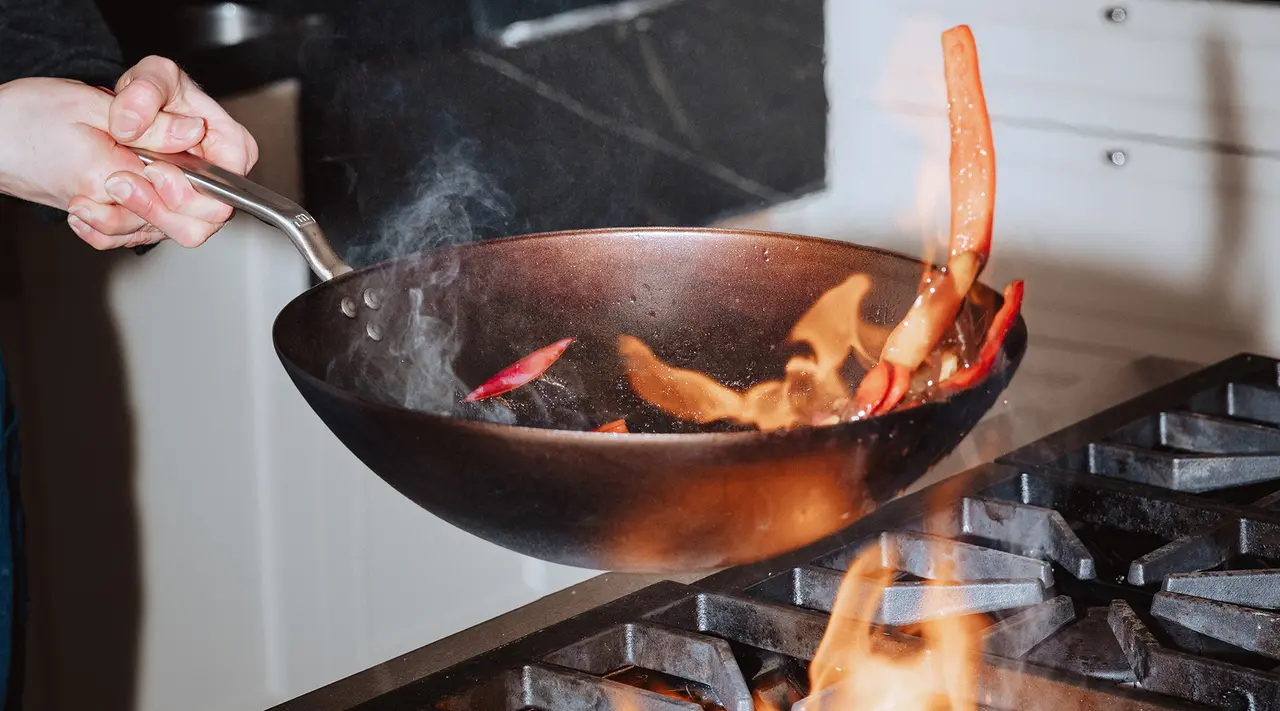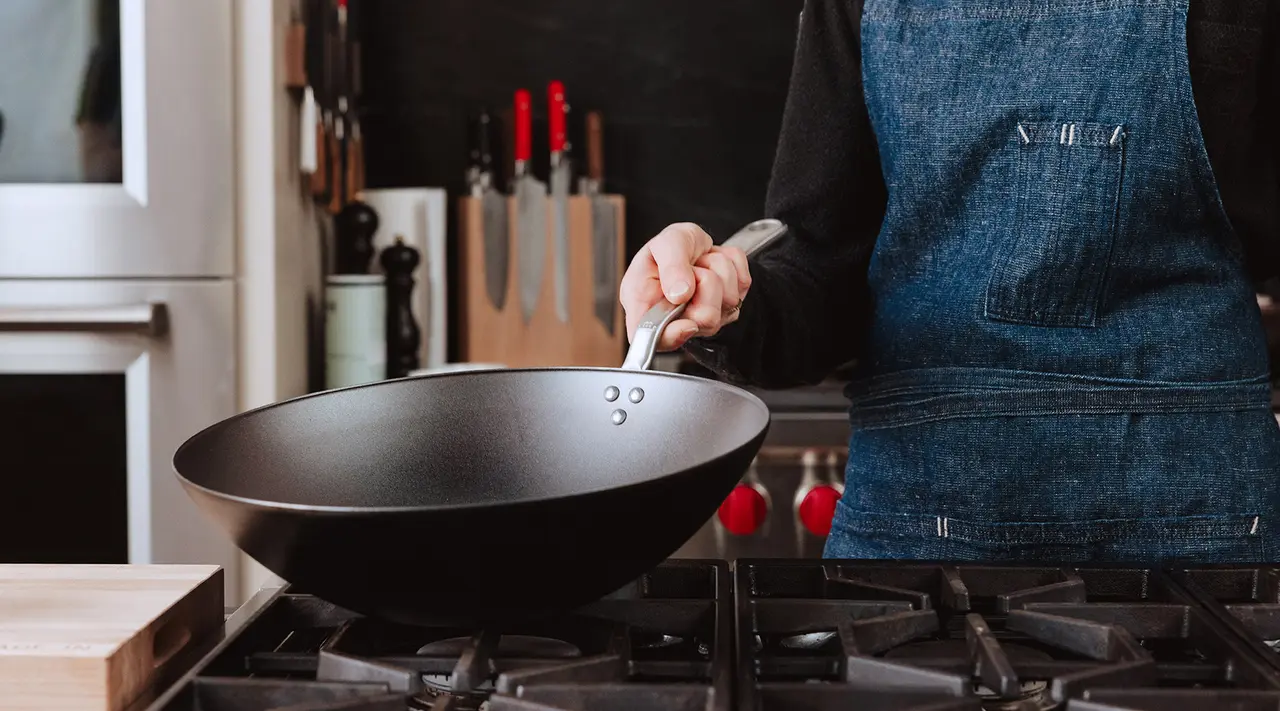If we told you how often we use our wok, you’d think we were a little too obsessed with making stir-fries. Yet while this rapid, intensely smoky, high-heat cooking method is the wok’s main claim to fame—and among our favorite uses for our pre-seasoned Carbon Steel Wok—it’s far from the only reason to devote precious cupboard space to it.
That’s why we’re showing you all the ways a wok can fit into your daily cooking regimen, whether you eat a lot of fried rice or not.
5 Wok Uses

From steaming and blanching veggies to tender-crisp perfection to smoking your proteins indoors, these are some of the lesser-known (but majorly delicious) ways to utilize your wok.
Stir-Frying
We had to start with a classic. What is it about the wok, exactly, that makes it so well-suited to stir-frying? To start, there’s the shape: tall, with dramatically sloping sides and a wide brim, the wok is designed to make it as easy as possible to toss and stir your food. The ample cooking surface delivers heat quickly and evenly to every individual piece of food, and allows moisture to rapidly dissipate. All this—combined with the fact that woks are typically made from high heat-resistant metals like carbon steel—is what makes the wok so unique (and so uniquely great at stir-frying).
So what can you stir-fry, you ask? Honestly, so long as your food is cut up into small-ish uniform pieces, the sky is pretty much the limit: shrimp, sliced pork belly, tofu, you name it. And while you won’t achieve proper wok hei—i.e., that ineffable smoky richness associated with many Chinese restaurant dishes—on a conventional gas stove, you can get close by cranking the burner up as high as it can go, and making sure your food is as dry as possible before adding it to the wok.
Deep-Frying
Craving feather-light shrimp tempura, homemade karaage, or crispy fried brussels sprouts? You’re in luck: the wok’s unique shape makes it excellent for deep frying, with the wide brim making it easier to reach in and pluck morsels of food out with tongs or chopsticks. Because of the narrow base, wok frying also requires less oil than other vessels, such as a Dutch oven or stock pot, while holding the same amount of food.
To safely and effectively use your wok for deep frying, make sure to follow the following protocol:
- Only fill your wok to about halfway up the sides (overfilling can lead to hot oil splatter).
- Make sure the base of the wok is centered directly on the burner, as its relatively small base makes it slightly less stable than a Dutch oven or other pot.
- Use only high smoke point oils like canola or grapeseed.
- Fry in small batches, and stick mainly to small pieces of food: while you can fry larger items like chicken legs, the wok’s shape won’t allow for more than one or two large items at once.
Steaming
Trying to cut back on oil, but still want crisp, flavorful food? Luckily, the wok is also a champ when it comes to steaming. In addition to helping retain the nutrients, flavor, and vibrant colors of food, wok steaming is your ticket to soft, fluffy bao buns; toothsome har gao and gyoza; and flaky, tender fish. Plus, bamboo steamers were literally designed to fit inside a wok: just line the bottom with a bit of parchment paper—or, more traditionally, cabbage leaves—boil your water, and add your food.
Boiling and Simmering
The wok’s wide, conical shape makes it an ideal vessel for deep frying, and the same factors make it a solid choice for boiling, blanching, and simmering. In addition to simmering stocks and soup broth, a wok is a great tool for making one-pot meals: quickly par-cook veggies or noodles before dumping out the water, then add oil and crank up the heat for a stir-fry.
Smoking Foods
While stir frying over high heat can help infuse your food with a rich, smoky intensity, you can amp it up even further by turning your wok into a literal smoker. This requires plenty of heavy-duty tin foil; something to burn, like mesquite or charcoal; and a Sheet Pan Rack to keep your food elevated. Finally, you’ll need something to cook: we love smoking proteins like salmon and brisket, as well as eggplant and other hearty vegetables.
- First, line your wok with foil to protect the inside from scratches/make it easier to clean up later, then spread your wood or charcoal in an even layer.
- Pop the Sheet Pan Rack over the top and spread your food out on top of it.
- Next, place your wok on the burner and crank the heat up to medium high.
- Once your wood or charcoal begins to burn, carefully seal up the pan—rack, food, and all—with more foil. Leave your food to smoke for about 30 minutes.
Why Carbon Steel Woks Are Best for All These Uses

When we talk about all the benefits of wok cooking, we’re mainly referring to one particular variety of wok: carbon steel. Carbon steel woks are lightweight yet durable; naturally non stick when properly seasoned; and offer better heat distribution and responsiveness than cast iron. All of these qualities make for a wok that’s easy to maneuver, cooks food quickly and evenly, and won’t warp or scorch over high heat.
Ready to Cook?
By now, we’ve hopefully convinced you that the wok is way, way more than just a one-hit wonder—and that carbon steel offers the best bang for your buck. Spacious but light and maneuverable, capable of handling both scorching high temperatures and gentle simmers, and—last but not least—naturally non stick, our Carbon Steel Wok is the closest thing you’ll find to an all-purpose piece of cookware.































